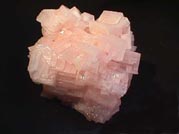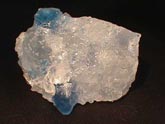 |
|
 Halite Halite |
|
Source: World wide Chemical: NaCl Sodium Chloride (Table Salt) Crystal System: Cubic Formation: Crystallized sea salt in evaporation areas such as shallow salt water lagoons and shallow inland salt seas. Properties: This is what is commonly known as table salt. Or rock salt. Just in its original crystalline form. In the United States halite forms in huge salt domes which have been mined for its salt for many years. Now, some of those domes are empty and are used to store the nation's oil reserves. Halite will taste salty (of course). But you should not use this test to identify an unknown mineral that may look like halite. Arsenic also has a salty taste...just before it kills you. And interesting note about salt for gemological purposes is that if you do not have a sodium D light available for use with a refractometer, a candle with some table salt on top with the wick will cause the sodium of the salt to be drawn into the flame producing an artificial...or perhaps it truly natural....sodium D light source for your refractometer. Below you will find an unusual blue color of halite in a massive form of white halite known as rock salt. ....
|
|
